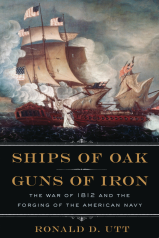The USS Constitution and HMS Guerriere battle during the war of 1812.
We think of the War of 1812 as one of the nation’s lesser wars (2,260 U.S. KIA), perhaps on par – in our collective memory, at least – with the Spanish-American (385) and Mexican-American (1,733) conflicts. But in this, the 200th anniversary of the start of that war between the U.S. and Britain – really, a second American war of independence, as it has been called – was a key coming-on-age test for what was basically a teen-aged nation.
In a new book on the conflict, Ships of Oak – Guns of Iron, Ronald Utt argues that this conflict telegraphed the young nation’s coming of age. Although it started the war over a variety of issues – British trade restraints and the impressment of U.S. merchant seamen into the Royal Navy chief among them — it didn’t prevail. But Utt, a former senior research fellow at the Heritage Foundation and a longtime maritime history buff, argues that the war set the nation’s course for the future. Battleland chatted with Utt about his book via email this week:
What surprised you most as you researched and wrote Ships of Oak – Guns of Iron?
The seeming enthusiasm of the young men on both sides of any battle as the ships closed for mortal combat in which there would be many casualties and poor medical care. These battles continued until one ship sank or surrendered after being severely battered and losing much of its officers and crew to death or wounds.
You argue that the War of 1812 helped make America into a superpower. How?
It was the view of Charles Francis Adams –- great-grandson of John Adams and one of America’s preeminent historians at the time — in his key note address at the 1912 annual meeting of the American Historical Association.
He used the term “world power,” and it is was his belief that our early naval successes against Britain in the war — then the mightiest naval power in the world — earned us the respect of the major European powers, and discouraged them from interfering in our affairs or sovereignty.
In turn, this new found confidence may have led to the Monroe Doctrine and later to the Mexican War where the U.S. acquired vast areas of territory from Mexico.
What was the mood of the American public during this conflict?
The mood during the war was very divisive.
Most of the support for it came from western and southern states, while states in the northeast opposed it. The June 1812 Declaration of War were the closest votes ever for a war, and deadly riots occurred in Baltimore early on between pro and con factions.
Many Americans along our northern border supplied the British army in Canada with foodstuffs, and states in New England later organized the Hartford Convention which some believe could had led to secession had the war lingered on into 1815.
Was there a U.S. Navy before the War of 1812? How did that war forge it?
The U.S. Navy and Marine Corps were disbanded in 1785 for budgetary reasons, but recreated in 1794 in response to the depredations of the Barbary pirates against U.S. merchant vessels in the Atlantic and Mediterranean.
The new navy fought the Barbary pirates and also fought the Quasi War with France prior to the War of 1812, but neither of these wars saw the level or intensity or conflict between evenly matched ships as did the War of 1812. It was in this war that we achieved major victories against a world naval power that had 500 ships to our 17.
[The U.S. Navy] did not defeat the British Navy, but during the first seven months of war the score was five-to-one in favor of the Americans in ship-to-ship combat. But the empire struck back and bottled up our fleet in the Atlantic ports for much of the remainder of the war.
By contrast, naval warfare continued — on the lakes, first on Lake Erie and then on Lake Champlain where in each case an American squadron defeated and entire British squadron and captured all of their ships.
Tell us about some of the military advances that first appeared in the War of 1812.
The biggest advance at the time was the advent of steam-powered ships, but its application was then only to commercial vessels, though apparently thought was given to applying it to one ship used on Lake Champlain.
Nonetheless, American ship designers introduced a number of technical design and material innovations in our big frigates that allowed them to easily defeat the British frigates in the early stages of the war.
What is the most surprising fact Americans don’t know about the war?
That black Americans were a significant presence on our warships at the time, serving the guns and trimming the sails. Historians estimate that the black presence on ships averaged 15 to 20%, but in one case (the Hornet) it may have been as high as 50%. There also served on many of the 500 privateers that America sent to sea during the war.




